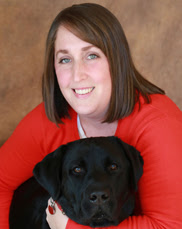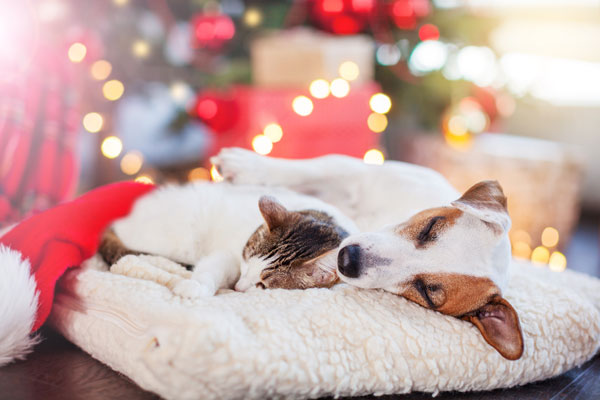Feline Hyperthyroidism
Written by Jessica Lewis, DVM and Jennifer Blair, DVM, CVA, CVFT
Hyperthyroidism is a multisystemic disorder resulting from the excessive production and secretion of thyroid hormones by the thyroid gland. This is almost always the result of an intrinsic disorder of the thyroid gland itself, either hyperplasia (increased number of thyroid hormone-producing cells), benign tumors (adenomas) or less commonly, malignant tumors (carcinomas) of the thyroid gland. Approximately 20% of cats will only have 1 lobe affected, whereas the other 70-80% have bilateral involvement. Occasionally, animals will have ectopic thyroid tissue in the lower neck or chest that is causing the signs of hyperthyroidism. We have yet to uncover what stimulates this excessive growth or tumor formation within the thyroid gland, but both environment and diet have been implicated.
Hyperthyroidism is most common in cats older than 8 years of age and there is no sex predilection. Because thyroid hormones are responsible for the body’s metabolism as well as several bodily functions, an overproduction of these hormones can lead to a variety of clinical signs. These may include weight loss, increased appetite, hyperactivity, restlessness, haircoat changes, increased water consumption and urination, vomiting, diarrhea, and aggressive behavior. Occasionally, cats will present with uncommon signs such as lethargy, weakness, and a lack of appetite. The owner may also notice an enlargement in the neck. Because this disease causes such a variety of signs, it should always be suspected in any older cat with medical problems.
Cats with hyperthyroidism may have concurrent problems with their heart and kidneys. Hypertrophic cardiomyopathy is a condition of the heart in which the walls of the heart thicken and the heart has difficulty adequately pumping blood to the body. Your veterinarian may detect an increased heart rate, heart murmurs, rhythm disturbances, or signs of heart failure on physical examination. Very rarely, these cats will present with the dilative form of cardiomyopathy in which the heart walls have become thinner and the heart larger, resulting in a decreased ability to pump blood. In addition, many cats with hyperthyroidism have concurrent renal disease or failure (approximately 30%). Often times, there may not be clinical signs of renal failure because the hyperthyroid cat has increased blood flow and perfusion to the kidneys. In these cases, treatment of the hyperthyroid state may lead to a decompensation of the kidney failure due to a decrease in blood flow.
Diagnosis
Diagnosis of hyperthyroidism begins with a complete medical history and a thorough physical examination. A minimum data base including a complete blood count (CBC), a serum chemistry profile, and a urinalysis can help detect concurrent diseases and establish baseline data prior to treatment.
Hyperthyroidism is often diagnosed on the basis of clinical signs, a palpable thyroid nodule in the neck, and the finding of an increased serum T4 concentration. Thyroxine or T4 is one of the thyroid hormones produced by the thyroid gland and is elevated in the majority of hyperthyroid cats. However, it is possible for this test to be in the normal range in cats with mild hyperthyroidism or in cats that have a concurrent illness lowering the T4 levels. If your veterinarian strongly suspects hyperthyroidism and this test initially is normal, he or she may suggest repeating the test or submitting a serum free T4 test (a more specific version of the hormone). Other diagnostics that can be performed include a T3 suppression test or a TRH stimulation test, both tests that assess the thyroid hormones and their pathways in the body. These, however, are rarely performed. Occasionally radionuclide thyroid scanning is necessary. With this test, a radioactive substance is injected into the bloodstream. It is preferentially taken up by functioning thyroid cells and can be very useful in detecting ectopic thyroid tissue.
If concurrent diseases are suspected, chest x-rays, abdominal x-rays, and an echocardiogram (ultrasound) of the heart may be warranted.
Treatment
There are four modes of therapy for hyperthyroidism: oral antithyroid medications, radioactive iodine, diet and thyroidectomy (surgical removal of the thyroid gland). Both radioactive iodine and thyroidectomy are aimed at curing the disease, while oral antithyroid medications and diet serve only to control the signs of hyperthyroidism. The mode of therapy depends upon the age and health of the cat, the status of the renal function, concurrent diseases, unilateral vs. bilateral involvement, and the owner’s wishes.
Antithyroid medications inhibit the synthesis of thyroid hormones. These medications are indicated for a treatment trial to assess the effect of resolving hyperthyroidism on renal function, alleviate symptoms prior to surgery or radioactive iodine therapy, or as long-term therapy for hyperthyroidism. Methimazole is the medication of choice and is available as a generic tablet or under the brand name, Felimazole. Felimazole is the only FDA approved medication for hyperthyroidism in cats. It is important to wear gloves and wash hands thoroughly when handling this medication and avoid contact if you are pregnant or breast-feeding. Please discuss with your veterinarian if oral medication is difficult as there are compounding pharmacies available that can prepare other formulations including liquid or a transdermal gel.
This medication is started at a low dose range for 2-4 weeks, then the T4, CBC, and profile (i.e. methimazole panel) are rechecked and the dose altered accordingly. Ideally, the CBC, platelet count, and chemistry panel are performed frequently during the first 3 months of treatment. After that, testing can be done every 6-12 months. Adverse effects of methimazole include a decreased appetite, vomiting, lethargy, facial itching, liver disease, bleeding episodes, decreased numbers of platelets, and other blood cell abnormalities. The major disadvantage of this treatment, aside from the risks of adverse side effects, is that it must be given once to twice a day for the life of the cat.
Radioactive iodine therapy is an excellent mode of therapy that can result in a clinical cure of hyperthyroidism. Iodine 131 (I131) is concentrated within the thyroid gland and the emitted radiation destroys the surrounding functioning thyroid cells without causing radiation damage to surrounding structures. Any cells that are atrophied and nonfunctioning are spared (and later become functional once the hyperthyroidism is controlled), which is why most cats treated this way do not have problems with hypothyroidism later in life (decreased thyroid hormones). Approximately 2% of cats will become hypothyroid, 2-4% will require a second I131 treatment, and 2% will have a recurrence of the disease within 1-6 years of treatment. The disadvantage of this treatment is a prolonged hospitalization (approximately 1-2 weeks) while the cat is considered to be ‘radioactive’.
Hill’s y/d is a prescription diet that has a limited iodine content. Feeding this diet exclusively can improve thyroid health in select cases. It is rarely successful as a sole treatment strategy, but may be a useful adjunct if medical therapy with methimazole is used.
Finally, surgical thyroidectomy has historically been performed to remove the diseased thyroid gland(s), but this procedure is no longer routinely performed due to the possible risks and side effects. Ideally this procedure would offer a complete cure, but clinical signs of hyperthyroidism may recur months to years after surgery. Clinical signs will also persist if there is any ectopic thyroid tissue, if a small portion of the thyroid was left in place, or if a malignant thyroid carcinoma had metastasized to other locations. The biggest risk of surgical thyroidectomy is the removal of the parathyroid glands. These are small glands located in close proximity to the thyroid glands. They are necessary for calcium balance in the body and their removal results in the serious complication of hypocalcemia (low calcium). In addition, thyroidectomy is contraindicated if the risk of anesthesia is too great or if renal function is poor.
If your cat is diagnosed with hyperthyroidism, discuss these possible modes of treatment thoroughly with your veterinarian and determine which one is best for your cat. If you have any questions on feline hyperthyroidism, please reach out to us at (651) 645-2808 or group@stfrancisabh.com.
Employee Spotlight: Kelly Wessels, CVT
Each month, we will spotlight one of our team members in order of years of service at St. Francis Animal Hospital.
Kelly joined St. Francis Animal Hospital in 2003 soon after graduating from Argosy University with her Associate of Applied Science (AAS) degree in Veterinary Technology. Kelly is a Certified Veterinary Technician (CVT), and is one of our most experienced veterinary technicians. Her professional interests include veterinary anesthesia, surgery, dentistry, and radiology. She has played an important role in developing our anesthesia, surgical, and dental protocols, as well as our Radiology Policies & Procedures manual for St. Francis.
Kelly serves as one of our Senior Veterinary Technicians. In addition to her technician duties, she serves as our Inventory Manager managing inventory and purchasing, our Radiation Safety Officer (RSO), and our Veterinary Technician Supervisor involved in the management and training of the veterinary technician team.
Outside of work, she shares her home with her husband, Tim; a black Labrador, Howard; and our retired clinic cat Tobias Matthew.

Why do you love being a veterinary technician?
Being a certified veterinary technician means making a difference in the lives of animals and people daily. I also never experience the same day twice. I am proud to be the voice for the animals.
Why do you love working at St. Francis Animal Hospital?
St. Francis is a close, tight knit community of providers, patients and clients. Seeing the familiar faces on a weekly or even daily basis makes my job that much more enjoyable.
Thank you, Kelly, for all you do at St Francis!
Happy Holidays: A Year In Review
Happy Holidays from all of us at St. Francis Animal Hospital! We’ve had a busy year and wanted to share the highlights with you.
Molly Moy was named the MN VPMN Practice Manager of the Year and Dr. Patricia Novak earned her certification in Hospice & Palliative Care (CHPV) from the International Association of Hospice & Palliative Care (IAAHPC).
We were voted Nextdoor’s Neighborhood Favorites: Favorite Veterinarian and Roseville Review’s Best Place for Pet Care.
St Francis Integrative Services has continued to grow by leaps and bounds.
We were excited to add Dr. Jessica Lewis as an associate veterinarian in May. We added two directorships: Dr. Katie Cartledge: Medical Director and Dr. Stefan Knep: Director of Equipment & Technology.
Laura Berg, CVT and her husband, Dan, welcomed their son, Everett, and Sabrina Reed, CVT, and her husband, Brian, welcomed their son, Vincent. We celebrated two weddings: Dr. Katie Cartledge and Colby Lowry and Cate Boisjolie and Danny Murphy. Katarina Ziegler became engaged to Brett Vandenbussche. We added Amelia Jordan, Amanda Mallek, Baylee May, Madison Baumgartner, Debranique Pitter, and Ellie Elsasser to the team.
We formed partnerships with Peaceful Passing for Pets and the Joy Session Network.
We celebrated milestone work anniversaries: Marie Adamczyk and Kelly Wessels: 15 years; Amanda Hernandez: 10 years; and Laura Berg and Sabrina Reed: 5 years.
St Francis celebrated its 26th year in business.
Thank you to all of you. We are so fortunate to have amazing clients and patients to work with each and every day. We are honored to care for your furred and feathered loved ones.
Wishing you all a wonderful holiday season!
News Briefs
Women’s Press Magazine’s What Women Want
Voting is open for Women’s Press Magazine’s What Women Want. Please vote for us for Favorite Animal Hospital or Veterinarian. To vote, click here.
Thank you so much for voting for us!
February Pet Dental Health Month
February is Pet Dental Health Month. We will not be offering discounts on dental procedures this year. Instead, take advantage of our ongoing promotion of $30 off if scheduled within 30 days of receiving an estimate. We will still offer 10% off of all dental products throughout the month of February.
Holiday Hours
Monday December 24th and Tuesday December 25th: Closed
Monday December 31st: 8:00 am to 3:00 pm
Tuesday January 1st: Closed
For after-hours emergencies, please contact the Animal Emergency & Referral Center,.
Image Credit: Shutterstock

